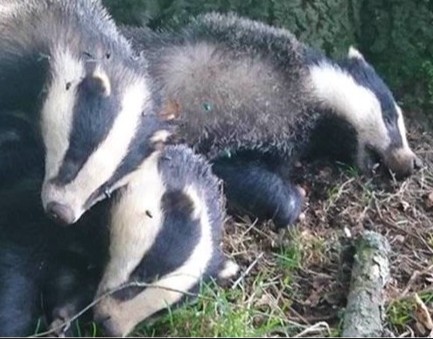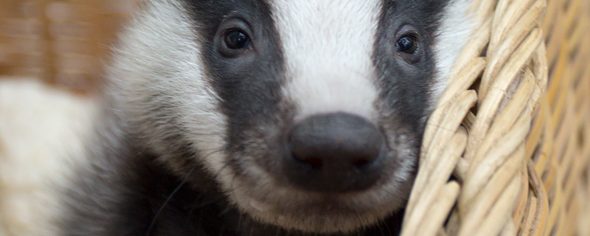 Eleven years of intensive badger culls in England have left over a quarter of a million mostly healthy badgers, dead using cruel methods. This has been justified on the back of a hypothesis that any infected badgers frequently spread bovine TB to cattle. There is very little science to back this up, and no credible evidence that culling badgers has any effect on cattle TB.
Eleven years of intensive badger culls in England have left over a quarter of a million mostly healthy badgers, dead using cruel methods. This has been justified on the back of a hypothesis that any infected badgers frequently spread bovine TB to cattle. There is very little science to back this up, and no credible evidence that culling badgers has any effect on cattle TB.
Badger culls aimed to reduce infected and uninfected badger numbers by 70% within cull areas, but population numbers are not known, confounding the basic assumption of the theoretical benefit. Badgers may be wiped out or bounce back quickly, but nobody is monitoring with any accuracy and reporting. This current policy of intensive culling is due to finish at the end of January 2026. But what happens after that? We may see an attempt to set something up very soon to take over, as the ruins of the current pro-cull government crumbles away with a shockingly bad record on nature protection.
 Public consultation on the next phase of Defra’s bovine TB eradication policy has been attempted for over a year, rowed back on, and is now thought to be imminent. The 2020 ‘Next Steps’ bovine TB policy suggested that the follow-on policy would aim to phase out intensive (70%) badger culling, but allow 100% culling (as in the failed Cumbria culling effort) but only in ‘exceptional’ circumstances.
Public consultation on the next phase of Defra’s bovine TB eradication policy has been attempted for over a year, rowed back on, and is now thought to be imminent. The 2020 ‘Next Steps’ bovine TB policy suggested that the follow-on policy would aim to phase out intensive (70%) badger culling, but allow 100% culling (as in the failed Cumbria culling effort) but only in ‘exceptional’ circumstances.
What will these ‘exceptional’ circumstances be?
It seems likely that to qualify as exceptional, a farm or defined area will need to have found a dead badger within an unknown distance which has tested positive for bovine TB or have been found with the same strain of bTB present in the local cattle. However, this proves nothing as the directionality of transmission is not known. You could cull badgers anywhere on this basis. It is not rational. We know that once a strain is introduced by cattle it can rapidly pollute the countryside with TB bacteria for considerable distance.
 Such culling attempts have been termed epidemiological culling, or ‘epi-culling’, which is a contradiction as it breaks many epidemiological principles and discredits the veterinary profession. Already the APHA Risk Pathways approach has been discredited following the successful independent report on the subject in 2023. The reasoning behind epi-culling sets a low bar in simplifying the implication of badgers infecting cattle, when presence of disease in badgers does not prove causation of disease in cattle. It never has done. The problem of undetected bTB in cattle is due to poor sensitivity of the tuberculin (SICCT) testing over decades. Poor testing and unwise cattle movements, coupled with residual infection remain by far the most likely cause of all herd breakdowns. The knowledge of the last ten years points directly towards the paucity of testing, while some researchers twist the evidence to bolster government policy.
Such culling attempts have been termed epidemiological culling, or ‘epi-culling’, which is a contradiction as it breaks many epidemiological principles and discredits the veterinary profession. Already the APHA Risk Pathways approach has been discredited following the successful independent report on the subject in 2023. The reasoning behind epi-culling sets a low bar in simplifying the implication of badgers infecting cattle, when presence of disease in badgers does not prove causation of disease in cattle. It never has done. The problem of undetected bTB in cattle is due to poor sensitivity of the tuberculin (SICCT) testing over decades. Poor testing and unwise cattle movements, coupled with residual infection remain by far the most likely cause of all herd breakdowns. The knowledge of the last ten years points directly towards the paucity of testing, while some researchers twist the evidence to bolster government policy.
It is almost as if this is a pre-planned effort to enable badger culling to become a free-for-all, and this has been suspected by some, from the beginning. Removal of badger protection by stealth, not science. The licensing method of future culling is unclear and if it is ‘farmer-led’ as the Godfray Report (2018) suggests, what will that mean in practice? Without cull companies and detailed veterinary supervision, the approach could be even more of a shambles than it has been thus far, particularly in terms of welfare. Details of the new plans are about to be made public shortly it would appear.
What will ‘epi-culling’ look like?
Since 2018 APHA have been experimenting crudely with ‘epi-culling’ in Cumbria and Lincolnshire. This new style culling aims to kill 100% of badgers within designated areas but of unclear size. This pilot has failed to eliminate bovine TB however, (see Chapter 5 of ‘A bovine tuberculosis policy conundrum in 2023′ ) and simply served to highlight recurrent infection in a handful of farms and how concentrated testing effort can remove bTB from a few dozen herds. Clearing of these herds by intensive effort will still leave the Cumbria Area 32 a full failure in terms of demonstrating that badger culling can reduce bTB in cattle. This is no model for the future.
Badger vaccination?
Vaccination of badgers may be offered after epi-culling from year 3 as in Cumbria Area 32. This is a massive operation that the NFU may have agreed to in some kind of deal enabling more culling. The entire Edge Area may potentially be available, with cluster areas already having been prepared. Wildlife Trusts and others may, if not careful, become obligated to support and justify the process of culling with the offer of vaccination follow-on. An unwise route, supporting the pretence that vaccinating badgers will help reduce disease in cattle. This is unproven and effectively a unsubstantiated deception that will be a cover for more badger culling, both licensed and illegal. Badger vaccination is likely to be offered for the HRA with possibly more culling – this is the biggest worry of all. We hope not. Badger Groups need to be aware of the risk of being manipulated to promote vaccination projects to farmers under false pretences, which will in effect facilitate more culling to 2038 and beyond.
Is badger culling scientifically justified & has it worked?
The science behind culling is uncertain & becoming unevidenced. A peer-reviewed paper, Langton, Jones, and McGill (2022) failed to find any association between the industry led badger culling 2013 – 2019, and either the incidence or prevalence of bovine TB in cattle herds.
 The paper has two main findings. Firstly, data show the slowing increase, levelling off, peaking and then decrease in bovine TB in cattle in the High Risk Area (HRA) of England during the study period, all well before badger culling was rolled out in 2016. This suggests that the cattle-based measures implemented from 2010, and particularly the introduction of the annual tuberculin skin (SICCT) test are most likely to be responsible for declines in disease.
The paper has two main findings. Firstly, data show the slowing increase, levelling off, peaking and then decrease in bovine TB in cattle in the High Risk Area (HRA) of England during the study period, all well before badger culling was rolled out in 2016. This suggests that the cattle-based measures implemented from 2010, and particularly the introduction of the annual tuberculin skin (SICCT) test are most likely to be responsible for declines in disease.
The second finding came from a look at the amount of cattle bTB in areas that had undergone a badger cull and compared it with the amount of disease in areas that had not had culling. This was done over a six year period 2013-2019, so before and after culling was rolled out. Multiple statistical models checked the data on herd breakdowns over time and failed to find any association between badger culling and either the incidence or prevalence of bovine TB in cattle herds. Models that most accurately fitted the data were those that did not include badger culling as a parameter, suggesting that factors other than culling (time, cattle testing etc) were likely to be the cause of the reduction in disease in cattle.
Defra does not accept the findings of this peer-reviewed study but have not produced a credible peer-reviewed rebuttal to it, and (following the change of DEFRA leadership from Richard Benyon to Robbie Douglas-Miller) they still refuse to engage on the matter. They also refuse to release their ‘secret’ and withheld data, and thus-far have not produced their own published science to show that badger culling is effective in reducing bTB in cattle. A preprint (Birch et al 2023) by APHA staff is discussed here and here.
Following on from Langton et al, a pre-print looking at the original RBCT analysis has found that alternative & more appropriate analyses of the data found no effect of badger culling (Torgerson et al. 2023). This is important, because the RBCT has been used as the basis for all culls since 2013. If badger culling during the RBCT produced no measurable disease benefit, the justification for badger culling has no scientific rationale.
What about the ecological impacts of 100% badger removal?
Under Judicial Review of their decision to licence badger culling, DEFRA undertook in 2018 to monitor the ecological impacts of 70% badger removal. This has not happened, with some vague fox count numbers used as a smoke screen. There was cheating and disgraceful behaviour in court in 2022.
So what will be the ecological impact of trying to remove entire populations of badgers, in patchy ways? What will be the licensing requirements for epi-culling and how will species and habitat impact assessments be provided? How will Tony Juniper at Natural England continue to support culling? Will he keen to keep saying that there is nothing to see?
Despite the frailty of the science behind badger culling, despite the lack of monitoring of the ecological impacts of culling, despite the financial cost and the cruelty, it looks as if the government is about to proceed with yet another ugly and ill-conceived badger culling consultation for its disastrous bovine TB policy.
Discover more from The Badger Crowd - standing up for badgers
Subscribe to get the latest posts sent to your email.

